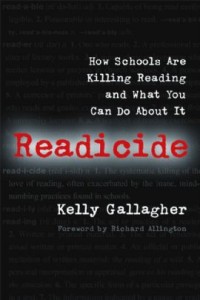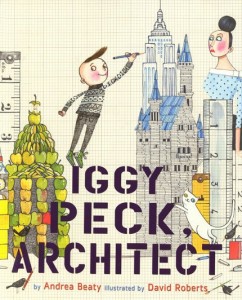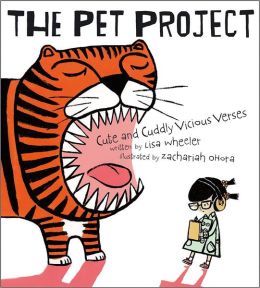Body Actions
 There seems to be a direct correlation between the amount of days left in a school year and the amount of time students are able to sit still and focus. Now is the time to grab interesting, interactive, move-your-body books like Body Actions by Shelley Rotner and David A. White.
There seems to be a direct correlation between the amount of days left in a school year and the amount of time students are able to sit still and focus. Now is the time to grab interesting, interactive, move-your-body books like Body Actions by Shelley Rotner and David A. White.
Body Actions is the kind of informational book with enough facts to be useful in a science unit and it’s still engaging enough to read for pleasure. Shelley Rotner’s fabulous photographs of kids are the basis for all the pictures, and David A. White made the illustrations that go over the photos and show what’s happening inside each body. Facts like “you have 206 bones in your body, and more than 50 are in your hands” are shown with a photograph of a kid’s hands playing the piano and one hand has all the bones drawn inside it. Each body system – skeletal, cardiac, digestive, etc. – is represented in kid-friendly terms.
Share Body Actions with your students. After you amaze them with all the cool anatomy facts (you have about 650 muscles in your body!) let them test out their own personal models. In the book you’ll learn that “you take about 14 breaths a minute.” Get out the stopwatch and have your students test this for themselves. You can do these experiments as a whole class or create a center for students to try them in small groups or pairs. Students can time themselves for one minute and count each breath. Then, create challenges. How many breaths do you take after 20 jumping jacks? How many breaths do you take after sitting quietly for two minutes? Do your students blink about 15 times a minute? If your digestive tract is about six times longer than you are tall, measure yourself and multiply your answer to find out just how long that tract is.
If you have a digital camera and a printer, take photos of your students in action and let them draw in on the printed photo their digestive system, their lungs, their heart, etc. Or get the big rolls of paper out, let students trace each other’s bodies so they can make a life-size drawing of their amazing interiors. Spend a little extra time outside if you can, and put those bodies in action!
For more information, please visit shelleyrotner. com.
Read MoreReadicide
 I’m forgoing the picture book pick this week because I’ve just finished reading Readicide: How Schools are Killing Reading and What You Can Do About It by Kelly Gallagher and I need to talk about it with my education peeps.
I’m forgoing the picture book pick this week because I’ve just finished reading Readicide: How Schools are Killing Reading and What You Can Do About It by Kelly Gallagher and I need to talk about it with my education peeps.
I put off reading Readicide at first because of the subtitle “how schools are killing reading”. I know so many educators pouring every ounce of their energy into our students, and as someone with over 20 years of working with students, I took the title as yet another criticism of teachers. Gallagher, however, is a classroom teacher himself, and his indictment is not of those of us in the trenches so much as a call to reevaluate an educational system that focuses on test scores instead of lifelong learning.
For me, the big “yes!” points were:
1. Our kids need a variety of interesting fiction and nonfiction books, magazines, articles, etc. and time in school to read for enjoyment. We librarians are dedicated to getting great reading material in the hands of kids, so if you have a tough student who doesn’t seem interested in reading anything, call a librarian – we’ll hook you up.
2. Reading is more than just decoding the words on the page – prior knowledge is key to understanding. I consider myself to be good at reading, but put an installation manual for an appliance in front of me and I’m quickly stumped. I know what each word means (I think) and yet I don’t have the experience to get how it all goes together. Our kids need what Gallagher calls “a broad knowledge base” to succeed, and so we need to read aloud historical fiction, science, poetry, etc. and discuss of all kinds of topics. We can bring in lots of “real-world text” like magazines, speeches, essays, editorials, news stories (in paper or electronic form from reliable resources).
3. Just like movies have trailers to draw in audiences, a good booktalk can hook readers who’d otherwise pass up a great book. Simply having the books on my shelves won’t pull in every kid. It’s worth my time to “sell” books to individuals and classes.
The book is packed with facts and practical information but still is a quick read. I highly recommend picking it up this summer. It’s not a light-hearted beach read, but it will inspire you to find new ways to help all our kids love to read. Let me know what the big “yes!” points were for you!
Read More
Iggy Peck, Architect
 Long have I loved Andrea Beaty’s picture book series about a bear named Ted (grab Doctor Ted, Firefighter Ted, and Artist Ted from your local library and prepare to be charmed.) Then, I saw sitting on the shelf by the Ted books this gem, just waiting to tie in perfectly with science, math, and phonological awareness lessons.
Long have I loved Andrea Beaty’s picture book series about a bear named Ted (grab Doctor Ted, Firefighter Ted, and Artist Ted from your local library and prepare to be charmed.) Then, I saw sitting on the shelf by the Ted books this gem, just waiting to tie in perfectly with science, math, and phonological awareness lessons.
Iggy Peck, Architect written by Andrea Beaty and illustrated by David Roberts will grab young readers on page 1:
“Young Iggy Peck is an architect
and has been since he was two,
when he built a great tower – in only an hour –
with nothing but diapers and glue.”
The story about a young boy who loves to build and saves the day with his architectural skills is told in fantastic rhyme. (Hello, Common Core Standard of Phonological Awareness!) But the beauty of this book is that after you’ve used it in reading lesson, it inspires all kinds of science, art, and math extensions.
When his class is stranded on a small island, Iggy teaches his classmates how to construct a suspension bridge from “boots, tree roots and strings, fruit roll-ups and things”. After sharing Iggy Peck, Architect, pull out Bridges by Seymour Simon to learn more about suspension bridges and how they work (and pat yourself on the back for Integrating Knowledge and Ideas, you Core Standard wizard.) You may choose to forgo tree roots and boots, but challenge your students to plan and construct a suspension bridge, perhaps between two tables, with materials like string, paper, straws, etc. Students can use graph paper like David Roberts did when they draw up their plans, measuring actual distances and then scaling the distances down on paper before they build. Your students will be measuring, counting, drawing, predicting, and revising as they work. Keep architecture books like Bridges! Amazing Structures to Design, Build, and Test by Carol A. Johmann and Elizabeth J. Rieth, or the wonderful David Macaulay books on hand for those inspired by Iggy Peck. As Miss Lila Greer, the teacher in Iggy Peck, Architect realizes:
“There are worse things to do when you’re in grade two
than to spend your time building a dream.”
For more information about the author, go to andreabeaty.com.
For more information about the illustrator, go to davidrobertsillustration.com.
Read MoreFrom Bright Idea to Bookshelf
I had no idea when I started writing children’s books that it would take me more than twelve years to make my dream come true, or that the path to publication is rarely a straight line. So, on my new page “The Groundhog! From Bright Idea to Bookshelf”, I’m sharing each phase in the life of my picture book To See or Not To See, starting with the “what if…” wonderings and ending with my announcements of the multiple awards it will win. (Writers like to dream…)
If you’ve ever wanted to see your own writing on a bookshelf, if you have students who want to be writers, if you love kids’ books and always wondered about the process, please check out my new page by clicking the tab at the top of the website. And don’t forget to let me know which Groundhog you’d like to see, or not to see!
Read MoreMy favorite Earth Day book: Wangari’s Trees of Peace
 Sometimes I fear that I can’t make a real difference in helping the planet, but Wangari’s Trees of Peace: a true story from Africa by Jeanette Winter shows how powerful one person’s actions can be. Wangari Maathai was devastated to see how barren Kenya was after thousands of trees were cleared. Soil was eroding and crops wouldn’t grow. The birds were gone. Women walked for miles to gather firewood. “I can begin to replace some of the lost trees here in my own backyard – one tree at a time.”
Sometimes I fear that I can’t make a real difference in helping the planet, but Wangari’s Trees of Peace: a true story from Africa by Jeanette Winter shows how powerful one person’s actions can be. Wangari Maathai was devastated to see how barren Kenya was after thousands of trees were cleared. Soil was eroding and crops wouldn’t grow. The birds were gone. Women walked for miles to gather firewood. “I can begin to replace some of the lost trees here in my own backyard – one tree at a time.”
Wangari started with nine seedlings, which grew into a nursery. Wangari gave new seedlings to village women for them to plant, and gave them money to keep those trees thriving. When Wangari tried to stop the clearing of old trees, she was beaten and arrested. But her message of caring for the Earth was taking root just like her trees were, and because of her, Kenyan women planted over 30 million trees, saving their land and making life there better.
For Earth Day/Arbor Day/natural resources units/biography units/non-fiction read-alouds that you can finish in one sitting, this is my new go-to book. Just by reading it and discussing it with students, you’re hitting the Common Core Standard of Range of Reading (a biography that teaches science and social studies? Non-fiction score!) Wangari’s Trees of Peace is also excellent for an ecological cause-and-effect lesson, one of the big pieces of Key Ideas and Details. Using the book for reference, students can write and draw the effects of deforestation (crops wouldn’t grow, birds were gone, lack of firewood) and the effects of planting all those trees (women don’t have to walk so far to gather firewood, more birds, crops growing in the soil.) Winter’s picture book doesn’t delve deeply into the science of why a lack of trees leads to soil erosion, so you can share Planting the Trees of Kenya: the story of Wangari Maathai by Claire A. Nivola if you need to build that knowledge with your students. Use both books as resources for student writing and drawing, and now you’re Integrating Knowledge and Ideas!
If in the past you’ve received more apple-themed coffee mugs than you need as end-of-the-year teacher gifts, you can suggest that in lieu of a present for you, students can give a gift to us all by planting a tree. If you can spring for a seedling or if your parent-teacher organization will chip in, plant a tree with your students and let them help take responsibility for watering it (seeds are cool, but watering a visible seedling is way more exciting than watering a patch of dirt.) Wangari’s Trees of Peace may plant in your students a dedication to care for our planet.
Read More
The Pet Project
 As soon as I picked up this new poetry book, The Pet Project, I thought of the animal reports many of my students are doing and I knew I must get this book into the hands of those kids and their teachers! The Pet Project: Cute and Cuddly Vicious Verses written by Lisa Wheeler and illustrated by Zachariah Ohora begins with this ominous verse:
As soon as I picked up this new poetry book, The Pet Project, I thought of the animal reports many of my students are doing and I knew I must get this book into the hands of those kids and their teachers! The Pet Project: Cute and Cuddly Vicious Verses written by Lisa Wheeler and illustrated by Zachariah Ohora begins with this ominous verse:
Warning!
If you’re the type who oohs and ahhs
at furry faces, precious paws,
the words ahead may be alarming:
Animals aren’t always charming.
Considering that I’ve been giving stacks of informational animal books to teacher-friends for student research projects, this poetry book comes at exactly the right time. It’s poetry month (hello, Range of Reading Standard!) and each poem about a different animal just begs to be compared to an informational book that will confirm the cool, and sometimes gross, facts. (Integrating Knowledge and Ideas? Check!)
For example, if you’ve got students who’re interested in monkeys, share this gem:
Monkey
He looks so like a little man
with smiling teeth and grasping hand.
He chatters to his monkey friends,
but that is where the likeness ends.
His hair is full of bugs and lice.
He flings his poo – His aim’s precise.
His scream sounds like a banshee’s wail.
He swings from his prehensile tail.
And worst of all he smells so funky.
If he’s a man, then I’m a monkey!
After your students calm down from giggling over poo-flinging, the research-sparking discussion can begin. Do monkeys really fling poo? What does prehensile mean? Do monkeys really smell funky? Time to pull out the informational non-fiction books for a fact-finding expedition. I love that Wheeler never dumbs down her vocabulary (you’ll find query, devise, and formulate all in the second poem). Discussing all the wonderful words she chose will help you hit the Craft and Structure Standard. So one little picture book can help you teach three Common Core State Standards, kick off student-led research projects, enrich vocabulary, and strengthen the love of poetry. I think we’ve just found a new teacher’s pet in The Pet Project.
For more information on the author, please visit: lisawheelerbooks.com.For more information on the illustrator, please visit: zohora.com.
Read More






